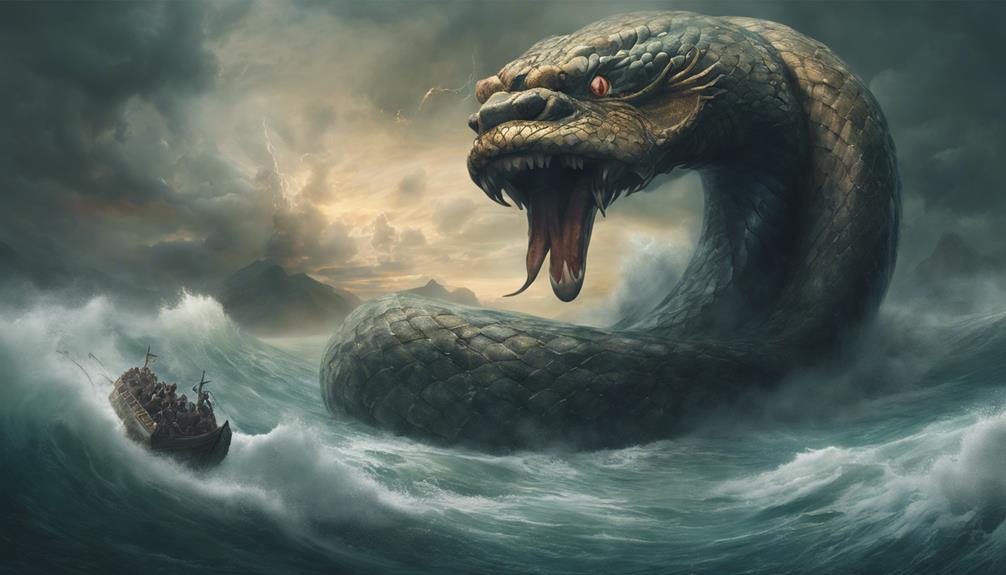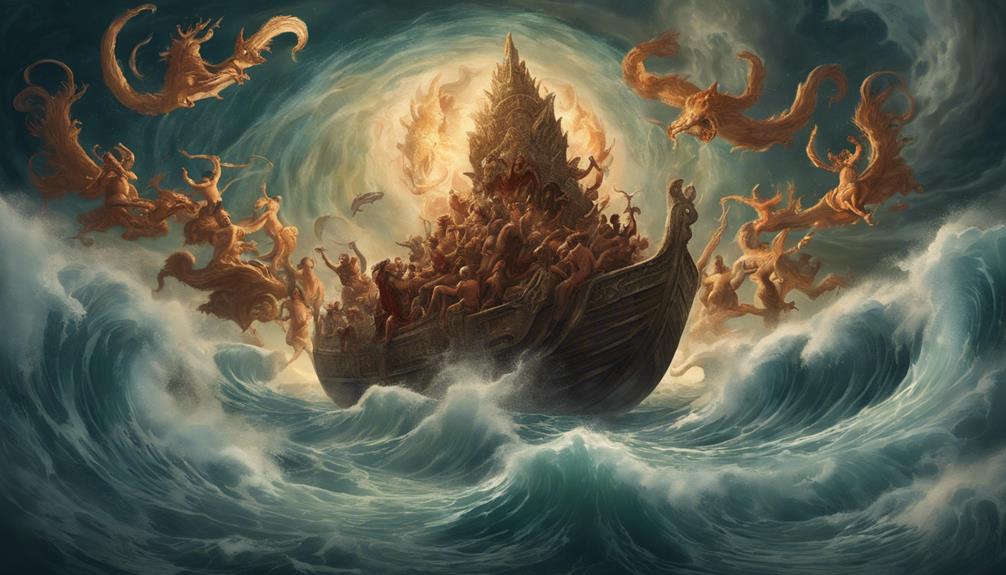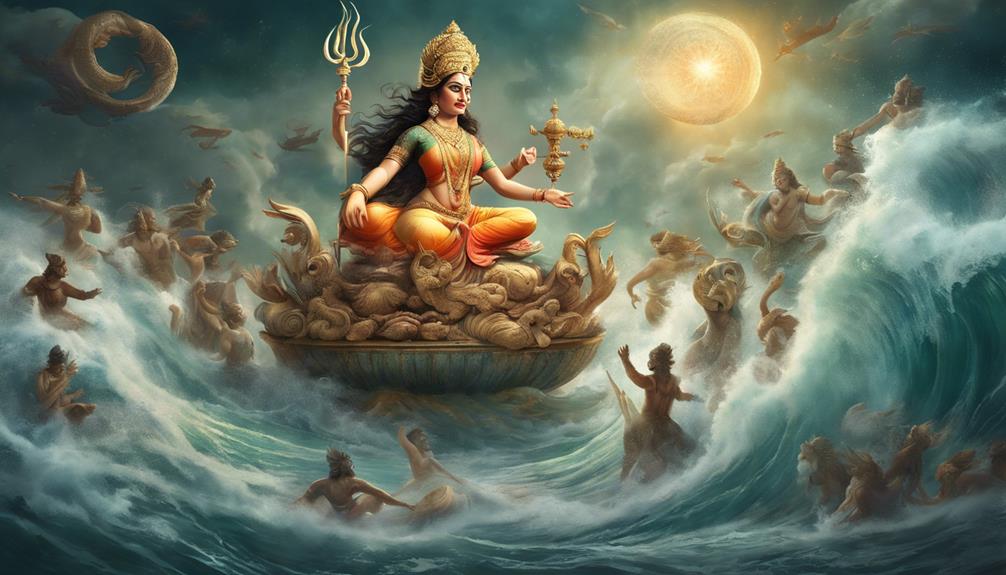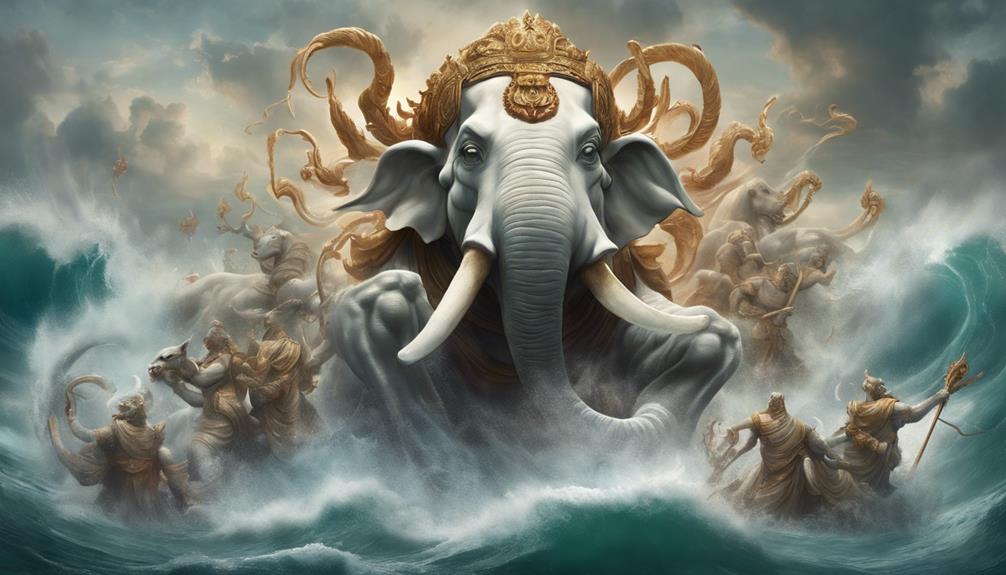Immerse yourself in the intriguing tale of the Churning of the Ocean (Samudra Manthan) where gods and demons join forces in a celestial battle, symbolizing the eternal clash between good and evil with layers of profound symbolism interwoven throughout. Discover the Mount Mandara's stability and the transformative power of Vasuki, as well as the emergence of the elixir and Halahala Poison, representing ultimate power and the cyclical nature of life. Explore deeper into this ancient narrative to unravel the hidden lessons and intricate symbolism that reveal the cosmic truths within.
Table of Contents
Key Takeaways
- The Churning symbolizes the cosmic battle between Devas and Asuras.
- Mount Mandara and Vasuki play crucial roles in the churning process.
- Emergence of elixir and Halahala poison signifies transformative forces.
- Divine beings like Lakshmi and Kamadhenu bring balance and blessings.
- The story imparts valuable moral lessons and symbolizes the eternal cosmic cycle.
Origins of the Churning
The origins of the churning of the ocean lie deeply rooted in Hindu mythology, symbolizing the eternal struggle between the forces of good and evil. This tale holds profound symbolic significance, representing the cosmic battle between Devas (celestial beings) and Asuras (demons) for immortality and the treasures of the universe. The Mythological origins of this epic event trace back to the time when Devas and Asuras joined forces to churn the ocean of milk using Mount Mandara as the churning rod and Vasuki, the serpent king, as the rope.
As the Devas and Asuras churned the ocean, a myriad of treasures emerged, including the divine elixir of immortality, known as Amrita. The churning process represents the inner turmoil and conflict within each individual, signifying the struggle to overcome one's inner demons and attain enlightenment. The churning of the ocean serves as a metaphor for the journey of self-discovery and the quest for spiritual evolution, where one must navigate through challenges and adversities to attain ultimate wisdom and liberation.
The Mount Mandara
Pivoting from the origins of the churning of the ocean, Mount Mandara emerges as a colossal and pivotal element in the celestial quest for immortality and enlightenment. The Mandara mountain, chosen to be the churning rod in the cosmic tug of war between the Devas (Gods) and Asuras (Demons), symbolizes stability, strength, and the ability to withstand immense pressure. Mount Mandara stands as a metaphor for the human journey towards self-realization, signifying the need to anchor oneself in unwavering determination when faced with life's challenges.
Mount Mandara's divine purpose unfolds as a beacon of hope amidst chaos, reminding us that even in the most turbulent times, there exists a steadfast core within us that can weather any storm. The symbolism of this sacred mountain extends beyond the physical domain, delving into the depths of spiritual significance, urging individuals to explore deep within themselves to discover their true essence. Just as Mount Mandara remained resolute during the churning, so too must one cultivate inner strength and resilience to navigate the unpredictable currents of life's ocean.
The Snake Vasuki

Emerging from the depths of the cosmic waters, coiled in intricate patterns of significance and power, lies the serpentine embodiment of duality and transformation – Snake Vasuki. In Hindu mythology, snakes hold deep symbolic meanings, representing both creation and destruction, life and death. The divine serpent, Vasuki, plays a pivotal role in the cosmic drama of the churning of the ocean, symbolizing the dual nature of existence.
Vasuki's presence as the rope used to churn the ocean signifies the delicate balance between opposing forces in the universe. As the gods and demons tug at either end of the snake, the symbolism of Vasuki becomes apparent – showcasing the eternal struggle between good and evil, light and darkness.
The intricate coils of Vasuki also represent the cyclical nature of life, where beginnings and endings are intertwined in an eternal dance of creation and destruction. As the divine serpent, Vasuki embodies the transformative power of change, reminding us that growth often emerges from the depths of chaos and conflict.
Gods and Demons Unite
In the cosmic tapestry of the churning of the ocean, gods and demons find themselves bound by a shared destiny, uniting in a harmonious yet precarious alliance. Deities and demons, usually at odds, set aside their differences in the face of a greater purpose. Unity is achieved, but not without challenges.
The gods, representing order and righteousness, and the demons, symbolizing chaos and malevolence, come together, showcasing a rare display of cooperation. This unexpected collaboration highlights the universal truth that even the most profound adversaries can find common ground when faced with a formidable task.
Despite their inherent animosity, the deities and demons realize that their destinies are intertwined, and only by working in unison can they hope to overcome the obstacles that lie ahead. This newfound unity isn't without its trials, as old grievances and suspicions threaten to unravel the fragile alliance. Yet, in this moment of shared struggle, a glimmer of hope emerges, showing that even the darkest of adversaries can find light when they stand together.
The Elixir Emerges

Amidst the tumultuous churning of the ocean, a transformative elixir begins to reveal its ethereal essence, beckoning both gods and demons towards a pivotal convergence. As the waters roil and the celestial beings pull with fervor, the elixir emerges, a symbol of ultimate power and immortality. The discovery of this elixir symbolizes the eternal quest for divine sustenance and enlightenment.
In this critical moment, the Devas and Asuras, usually at odds, find themselves united in their pursuit of this elixir, setting aside their differences and grievances. The elixir becomes a focal point of unity, transcending the usual boundaries of rivalry and animosity between these celestial forces. This unity signifies the potential for harmony and cooperation even amidst the most profound conflicts.
As the elixir glistens in the chaos of the churning ocean, it represents the promise of transcendence and transformation. Its emergence marks a turning point in the celestial domains, where even the most bitter rivals can come together in the face of something truly divine.
Halahala Poison
Within the tumultuous depths of the churning ocean, a potent venom known as the Halahala Poison emerges, embodying a malevolent force that challenges the very fabric of existence. Symbolizing the destructive aspects of creation, the Halahala Poison represents the inherent dualities that exist in the universe. Its emergence during the churning process signifies the balance between good and evil, creation and destruction, light and darkness.
The significance of the Halahala Poison lies in its role as a transformative agent. In Hindu mythology, this poison isn't merely a physical substance but a metaphor for the negative emotions and vices within individuals. By appearing during the churning of the ocean, it serves as a reminder of the continuous battle between positivity and negativity in the cosmic order.
The Halahala Poison's symbolism extends beyond its literal presence, delving into the deeper philosophical understanding of the cyclical nature of life. It underscores the necessity of facing and overcoming challenges to attain enlightenment and spiritual growth. Therefore, the Halahala Poison stands as a powerful allegory for the trials one must endure to achieve inner harmony and transcendence.
Birth of Goddess Lakshmi

As you witness the Birth of Goddess Lakshmi, you'll see more than just a deity emerging from the churning waters.
The emergence of Lakshmi symbolizes the manifestation of beauty, wealth, and prosperity in your life. Her significance goes beyond material wealth, representing the abundance of virtues and spiritual well-being that she brings along.
Lakshmis Emergence
Emerging from the frothy churn of the cosmic ocean, Goddess Lakshmi, radiant and resplendent, graced the world with her divine presence. As she emerged, petals of lotus flowers fell from her hands, symbolizing purity and fertility. The air filled with a sweet fragrance, and a gentle breeze carried her blessings to all beings.
Lakshmi's emergence signified the arrival of prosperity, wealth, and abundance in the universe. Her luminous form illuminated the surroundings, bringing hope and positivity to all. The celestial beings rejoiced at her presence, knowing that her blessings would bring harmony and fulfillment.
Lakshmi's divine emergence marked a new era of prosperity and well-being, where her benevolence touched the hearts of all who beheld her.
Lakshmis Significance
Goddess Lakshmi's significance shines through the very essence of her birth, a moment that heralded the dawn of abundance and prosperity in the cosmic domains.
She embodies divine blessings, symbolizing the epitome of wealth and prosperity. In Hindu mythology, her emergence during the churning of the ocean represents the eternal quest for spiritual enlightenment and material fulfillment.
Lakshmi's presence signifies not just material riches but also spiritual wealth, emphasizing the importance of balance and harmony in one's life. Her arrival brings forth a sense of fulfillment and completeness, offering a reminder that true abundance encompasses both the tangible and intangible aspects of existence.
Through her birth, Lakshmi illuminates the path towards embracing prosperity in all its dimensions, guiding souls towards a life filled with blessings and richness.
Kamadhenu – The Wish-Fulfilling Cow
Imagine a cow that embodies the essence of abundance and fulfillment, a creature of divine origins with the power to grant any wish. Kamadhenu, the Wish-Fulfilling Cow, symbolizes the limitless blessings that flow from the universe when one is in harmony with the cosmic forces.
Its magical abilities transcend the ordinary, offering a glimpse into the profound connection between the material and spiritual domains.
Kamadhenus Divine Origins
With divine origins shrouded in mystique and wonder, Kamadhenu, also known as the Wish-Fulfilling Cow, embodies the essence of abundance and blessings in Hindu mythology. Legend has it that Kamadhenu emerged during the churning of the ocean, gifted with divine miracles and the power to grant wishes.
This celestial being symbolizes fertility, nourishment, and prosperity, making her a revered figure in Hindu cosmology. Kamadhenu's blessings are believed to bring immense wealth, success, and fulfillment to those who worship her with sincerity. Her presence signifies the limitless abundance of the universe and the benevolence of the divine.
Through her mystical origins and miraculous nature, Kamadhenu stands as a beacon of hope and prosperity in the vast tapestry of Hindu mythology.
Kamadhenus Magical Abilities
Manifesting desires with a mere thought, Kamadhenu's magical abilities transcend the boundaries of reality, weaving dreams into tangible blessings. This divine cow possesses wish-fulfilling powers that can turn aspirations into realities.
With a gentle gaze or a flick of her tail, Kamadhenu can bring forth abundance, prosperity, and fulfillment. Her mystical aura emanates a sense of tranquility and hope, symbolizing the infinite potential that lies within the universe.
Through her magical abilities, Kamadhenu serves as a beacon of light in the darkness, guiding those in need towards their heart's truest desires. The legend of Kamadhenu embodies the profound belief in the power of intention and the boundless capabilities of the universe to manifest miracles.
Airavata and Uchchaihshravas

The majestic Airavata and the divine Uchchaihshravas emerged from the churning seas, their presence illuminating the cosmic dance of creation and power in the ancient tale of Samudra Manthan.
Airavata, the white elephant, symbolizes purity, strength, and wisdom. His six pairs of tusks represent the directions in the universe, while his ability to control the clouds reflects his role in bringing rain and fertility to the Earth.
Uchchaihshravas, the seven-headed celestial horse, embodies swiftness, endurance, and grace. Each of his heads signifies the seven chakras, balancing the spiritual energy within the cosmos.
Together, Airavata and Uchchaihshravas stand as divine beings, embodying the duality and harmony of creation. Their emergence from the ocean of milk during the Samudra Manthan signifies the balance of power and wisdom required for the sustenance of the universe.
In their symbolism, these magnificent creatures remind us of the intricate interconnectedness and balance that underlies the cosmic order.
Lessons and Symbolism
As you reflect on the Samudra Manthan story, consider the profound symbolism woven into the churning of the ocean. The narrative holds valuable moral lessons that resonate through time, offering insights into perseverance, cooperation, and the cyclic nature of life's challenges.
Symbolism in Samudra Manthan
Symbolism in the Samudra Manthan story intricately weaves profound lessons and symbolic meanings into the fabric of Hindu mythology, offering a tapestry of wisdom waiting to be unraveled.
The churning of the ocean symbolizes the eternal cosmic cycle of creation and destruction, mirroring life's continuous ebb and flow.
The Mount Mandara represents the axis mundi, the center of the universe, emphasizing the balance between opposing forces necessary for equilibrium.
The serpent Vasuki, used as the churning rope, signifies the primal energy within us that can lead to either destruction or enlightenment.
The various treasures and poison that emerge from the churning illustrate the rewards and challenges that come with seeking knowledge and self-realization.
This symbolic narrative serves as a reminder of the transformative journey towards inner growth and spiritual enlightenment.
Moral Lessons Conveyed
Commence on a journey through the depths of the Samudra Manthan story to uncover the profound moral lessons intricately woven within its symbolic tapestry.
The churning of the ocean symbolizes the eternal struggle between good and evil, teaching us about perseverance, unity, and the importance of working together for a common goal.
The story highlights the virtues of patience, determination, and sacrifice, as seen in the Devas and Asuras joining forces despite their differences.
It underscores the ethical implications of honesty and integrity, showing that righteousness and truth prevail in the end.
The values of selflessness, humility, and gratitude are exemplified through the actions of various deities, emphasizing the significance of selfless service and the rewards it brings.
Frequently Asked Questions
How Did the Churning of the Ocean Impact the Relationship Between the Gods and Demons in Hindu Mythology?
The churning of the ocean reshaped alliances between gods and demons, fueling a power struggle that altered dynamics of authority and trust. As the waters stirred, the delicate balance of power teetered on the brink.
What Role Did Vishnu Play in the Churning of the Ocean and Why Was He Chosen for This Task?
In the churning of the ocean, Vishnu's role was pivotal. Chosen for divine intervention, he guaranteed balance and harmony. His presence symbolized the cosmic order, guiding gods and demons towards a shared goal, showcasing his supreme wisdom.
What Significance Does the Halahala Poison Have in the Story of the Churning of the Ocean?
In the story of the churning of the ocean, the halahala poison symbolizes the trials and tribulations faced during transformative processes. Its significance lies in representing the inevitable challenges that must be overcome to achieve greatness.
How Did the Churning of the Ocean Lead to the Birth of Goddess Lakshmi and What Qualities Does She Represent?
Through the churning of the ocean, goddess Lakshmi emerged, symbolizing wealth, prosperity, and fortune. Her birth signifies the rewards of perseverance and righteousness. Lakshmi embodies beauty, grace, and abundance, bringing blessings to those who honor her.
Can You Explain the Symbolism Behind the Wish-Fulfilling Cow Kamadhenu and the Divine Horses Airavata and Uchchaihshravas in the Story of the Churning of the Ocean?
In the story of the churning of the ocean, the wish-fulfilling cow Kamadhenu symbolizes abundance and prosperity, while the divine horses Airavata and Uchchaihshravas represent power and strength. Their presence highlights the symbolic significance of churning impact.
Conclusion
As the churning of the ocean unfolded, gods and demons came together in a powerful display of unity and determination. Through their efforts, the elixir of immortality emerged, symbolizing the rewards of perseverance and cooperation.
The birth of Goddess Lakshmi and the appearance of divine beings like Kamadhenu and Airavata added layers of meaning to this epic tale. The churning of the ocean serves as a timeless reminder of the importance of working together towards a common goal, even amidst challenges.